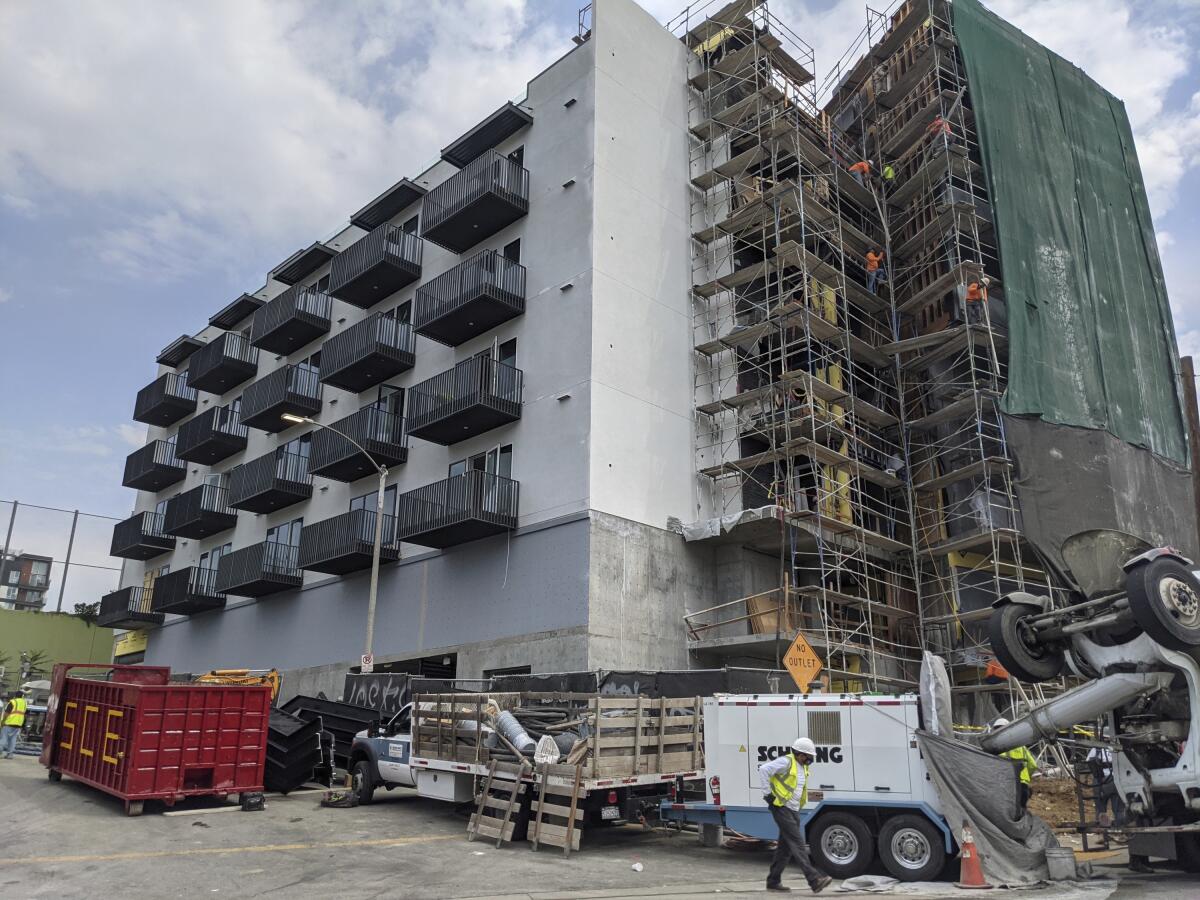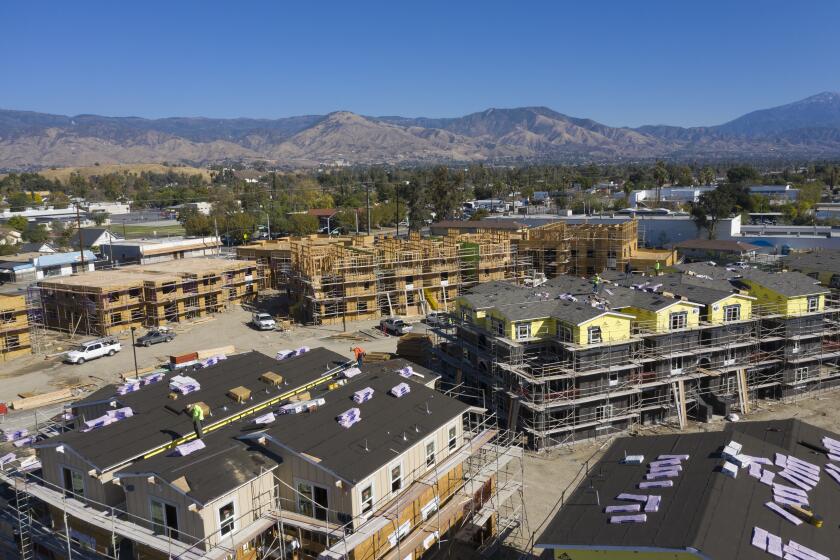California enacts two laws to slice through local zoning rules

- Share via
SACRAMENTO — California single-family neighborhoods could see existing parcels split in half to build new housing under a bill signed Thursday by Gov. Gavin Newsom, a plan more modest than far-reaching housing efforts in recent years but sharply criticized by officials in some cities as an overreach on decisions that should be left to local communities.
Newsom also signed a bill allowing more housing density in areas near public transit. Both bills will take effect Jan. 1 but neither is likely to produce the supply of new housing that experts have said California needs to erase years of pent-up demand.
“The housing affordability crisis is undermining the California dream for families across the state, and threatens our long-term growth and prosperity,” Newsom said in announcing his approval. “Making a meaningful impact on this crisis will take bold investments, strong collaboration ... and political courage from our leaders and communities to do the right thing and build housing for all.”
The most controversial of the new laws, Senate Bill 9, will allow up to four new housing units on a single property in certain neighborhoods that are currently zoned for standalone houses only. The law places limits on new construction in neighborhoods designated as historic. Tenants in existing homes would also have legal protections from being displaced. For lots that are split into two parcels, a homeowner must agree to live on the premises.
A similar bill failed to clear both legislative houses last year. Supporters said they made concessions this time to win passage, but the effort remained ensnared in fierce battles over the size and scope of new housing in suburban neighborhoods.
The impact of the new single-family neighborhood law, allowing what is often referred to as “upzoning,” may be limited. A summer study by the Terner Center for Housing Innovation at UC Berkeley found that most single-family parcels across the state would not see any new development — and nowhere near enough to fill a housing shortage that some have estimated to be as large as 3.5 million units.
The bill by state Senate President Pro Tem Toni Atkins (D-San Diego) would require cities to approve up to four housing units on what was a single-family lot. They would also have to approve splitting single-family lots so they could be sold separately.
“For too many Californians, the idea of owning a home, renting a house big enough for their family, or even just being able to live in the community where they work is a far-off dream,” Atkins said. “This law will help close the gap and make those dreams a reality.”
A bill to create an agency in L.A. County to build and preserve affordable housing was sacrificed to unnecessary political standoff with labor leaders.
Amid cities’ opposition, Atkins included ways local governments can block construction that might harm public safety or public health or benefit housing speculators. Property owners seeking to split a lot would have to agree to have one of the housing units as their principal residence for at least three years.
That’s not enough to keep from undercutting local control, 241 cities joined by the League of California Cities said in a letter to Newsom, though they acknowledged that affordability and homelessness “are among the most critical issues facing California cities.”
The new law “undermines the ability of local governments to responsibly plan for the types of housing that communities need, circumvents the local government review process, and silences community voices,” said league Executive Director Carolyn Coleman, noting that none of the provisions require that the new housing be affordable.
Newsom also announced the state will put $1.75 billion into what his administration is calling a new California Housing Accelerator, which he said will speed building 6,500 affordable multifamily units that had been stalled for lack of tax-exempt bonds and low-income housing tax credits.
It’s part of $22 billion that the state plans to spend to spur new housing and ease homelessness along with the new laws.
Newsom has made fighting homelessness a centerpiece of his administration and said he was spurred to even more urgency by a recall election that threatened to unseat him. Nearly two-thirds of voters rejected the effort to remove Newsom, according to unofficial election returns.
California’s median sales price for single-family homes is now $811,170, up 21.7% since July of last year.
The advocacy group California Community Builders has said legislation approved by lawmakers this year would help narrow a racial wealth gap in California, where more than 60% of white residents own their homes, compared with 35% of Black residents and about 40% of Latino residents.
Atkins’ measure was among those lauded this month by President Biden’s administration.
Newsom also signed a bill by Democratic state Sen. Scott Wiener of San Francisco easing the way for local governments to rezone neighborhoods near mass transit for up to 10 housing units.
Wiener made his bill optional in response to opposition, but the advocacy groups California YIMBY and California Community Builders still hailed its passage.
“It shouldn’t take five or 10 years for cities to rezone, and SB 10 gives cities a powerful new tool to get the job done quickly,” Wiener said.
Newsom said in a signing message that “certain provisions may have unintended impacts,” so he ordered housing officials to monitor its progress.
The enactment of the two legislative proposals marked an end of a notable chapter at the state Capitol in debates over California’s lack of affordable housing. Each represented less aggressive versions of proposals that were rejected for three years running, the last defeat taking place in January 2020.
After years of false starts, California state lawmakers seem primed to end single-family home only zoning across the state, effective next year.
Several Sacramento neighborhood groups argued that Wiener’s bill would keep more lower- and middle-class residents as perpetual renters because it encourages apartment building ownership by large financial organizations. They also objected that it undermines local control and environmental protections.
Sacramento officials aim to make California’s capital one of the nation’s first to eliminate traditional single-family zoning. Portland, Ore., and Minneapolis have passed similar ordinances in recent years. The state of Oregon passed a law eliminating traditional single-family zoning statewide.
Newsom also signed a bill extending a 2019 law designed to make it easier to build more housing throughout the state. That law had been set to expire until 2025, but now will remain in effect until 2030.
Lawmakers this year did not advance two other high-profile housing bills that would have made it easier to turn abandoned shopping malls into apartment buildings.
More to Read
Sign up for Essential California
The most important California stories and recommendations in your inbox every morning.
You may occasionally receive promotional content from the Los Angeles Times.












